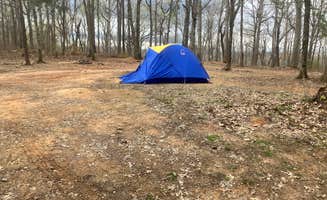Rustic camping near Clemmons, North Carolina requires preparation as most sites are situated in the Uwharrie National Forest region at elevations between 500-1,000 feet. The area experiences moderate humidity with summer temperatures averaging 85-90°F during peak camping months. Winter dispersed camping remains available at most locations but access roads may become difficult after rainfall or snow.
What to do
**Water exploration: Creek access points throughout Birkhead Mountain Wilderness Area provide natural swimming and fishing spots during warmer months. Small native trout populations can be found in the deeper pools. Rachael H. noted that there are "plenty of creeks" throughout the wilderness area.
**Trail navigation: Many dispersed camping areas connect to unmarked hiking paths. Robbins Branch Trail features interconnected routes suitable for day hikes or backpacking circuits. Local rangers recommend carrying paper maps as cellular service remains unreliable throughout most camping zones.
**Wildlife observation: Morning hours offer optimal wildlife viewing at Dispersed Camping off Falls Dam Trail. Dawn typically brings activity from deer, turkey, and various bird species. Daniel R. mentioned enjoying "the song of wind and birds" during his stay, highlighting the natural soundscape.
What campers like
**Natural isolation: Most primitive camping spots near Clemmons require minimal hiking to reach secluded areas. At Birkhead Mountain Wilderness Area, campers appreciate the quiet atmosphere and distance from urbanized areas. Sites typically offer 100+ yards between camping groups during non-peak periods.
**Accessibility without crowds: Dispersed camping locations provide alternatives to developed campgrounds with fewer restrictions. Despite proximity to Winston-Salem and Greensboro, weekday occupancy remains low even during summer months.
**Dark skies: The relative distance from major light pollution sources creates opportunities for stargazing. Campgrounds positioned away from forest canopy offer clear views of night skies. Campers report minimal light interference except during full moon phases.
What you should know
**Water planning: No potable water exists at Robbins Branch Trail or other dispersed sites. Campers must pack in all drinking water or bring filtration systems for creek water. The nearest reliable water sources are typically 8-12 miles from camping areas in surrounding towns.
**Navigation challenges: Trail intersections throughout the region often lack clear signage or markers. First-time visitors should download offline maps before arrival. GPS coordinates for intended camping spots help prevent disorientation, particularly if arriving after dark.
**Seasonal considerations: Spring and fall provide optimal camping conditions with moderate temperatures and reduced insect activity. Summer camping requires additional preparation for heat, humidity, and occasional thunderstorms that can develop rapidly in the region.
Tips for camping with families
**Site selection: Choose camping spots within 1-2 miles of trailheads when bringing children to primitive camping areas. Shorter hikes with minimal elevation change work best for families with young campers. Established fire rings indicate previously used sites that typically offer flatter terrain.
**Activities: Bring nature identification guides specific to North Carolina piedmont flora and fauna. Many camping areas feature diverse plant species and wildlife viewing opportunities appropriate for educational activities with children.
**Safety preparations: Birkhead Mountain Wilderness Area and similar rustic camping near Clemmons require basic first aid supplies. Cell reception remains inconsistent throughout the region, necessitating emergency planning. Always inform someone outside your group about your specific camping location and expected return date.
Tips from RVers
**Access limitations: Most dispersed camping areas near Clemmons have restrictions for larger vehicles. Access roads to primitive sites often include unpaved sections with potential clearance issues. Scout locations before attempting access with trailers or larger RVs.
**Site preparation: Dispersed Camping off Falls Dam Trail accommodates smaller RVs but requires careful positioning on uneven terrain. Bring leveling blocks and site assessment tools. Most areas lack designated parking pads, requiring campers to identify suitable locations upon arrival.
**Resource management: Plan for complete self-sufficiency at primitive camping locations. No dump stations exist at dispersed sites, requiring proper waste management and sufficient tank capacity for your intended stay duration. Generators are generally not permitted in wilderness camping areas.


